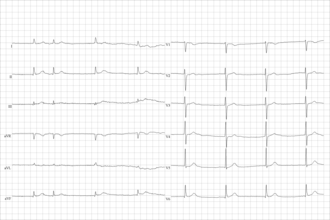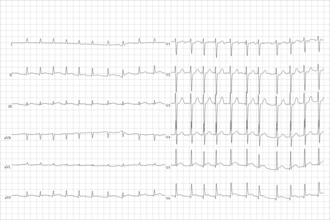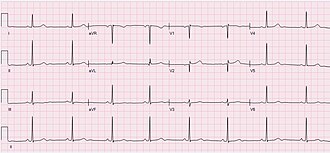Sinus node dysfunction

Editor-In-Chief: Prab R Tumpati, MD
Obesity, Sleep & Internal medicine
Founder, WikiMD Wellnesspedia &
W8MD medical weight loss NYC and sleep center NYC
| Sinus node dysfunction | |
|---|---|
 | |
| Synonyms | Sick sinus syndrome, sinus node disease |
| Pronounce | N/A |
| Specialty | N/A |
| Symptoms | Bradycardia, fatigue, dizziness, syncope |
| Complications | Heart failure, stroke |
| Onset | Typically in older adults |
| Duration | Chronic |
| Types | N/A |
| Causes | Fibrosis of the sinoatrial node, ischemic heart disease, medications |
| Risks | Age, hypertension, diabetes mellitus |
| Diagnosis | Electrocardiogram (ECG), Holter monitor |
| Differential diagnosis | Atrioventricular block, atrial fibrillation |
| Prevention | N/A |
| Treatment | Pacemaker implantation, medication adjustment |
| Medication | N/A |
| Prognosis | Variable, depends on underlying cause and treatment |
| Frequency | Common in older adults |
| Deaths | N/A |



Sinus node dysfunction (SND), also known as sick sinus syndrome (SSS), is a group of heart rhythm problems (arrhythmias) in which the heart's natural pacemaker (sinus node) doesn't work properly. The sinus node is an area of specialized cells in the upper right chamber of the heart that controls the rhythm of your heart. Normally, the sinus node produces a steady pace of regular electrical impulses. In sick sinus syndrome, these signals are abnormally paced. A person with sinus node dysfunction may have heart rhythms that are too fast, too slow, punctuated by long pauses — or an alternating combination of all of these rhythm problems. Sinus node dysfunction is relatively uncommon, but the risk of developing it increases with age. Many people with sinus node dysfunction eventually need a pacemaker to keep the heart in a regular rhythm.
Symptoms[edit]
Sinus node dysfunction often doesn't cause noticeable symptoms. When symptoms do occur, they may mimic those caused by other health problems, making the condition difficult to diagnose. Symptoms may include:
- Fatigue
- Dizziness
- Lightheadedness
- Fainting or near fainting
- Shortness of breath
- Chest pains
- Trouble sleeping or staying asleep
- Confusion or difficulty remembering things
Causes[edit]
Sinus node dysfunction is associated with damage to or degeneration of the sinus node — often the result of underlying conditions or medical treatments. Conditions that can cause or contribute to problems with the sinus node include:
- Aging
- Heart disease
- Medications, including some drugs for heart rhythm disorders, high blood pressure and psychiatric problems
- Sleep apnea
- Hyperkalemia (high potassium levels)
- Previous heart surgery near the sinus node
Treatment[edit]
Treatment for sinus node dysfunction usually involves addressing underlying health problems and reducing symptoms. If symptoms are severe or the condition is causing more serious heart rhythm problems, treatment may involve medications to control the heart rate or the implantation of a pacemaker.
See also[edit]
Ad. Transform your life with W8MD's Budget GLP-1 injections from $75


W8MD offers a medical weight loss program to lose weight in Philadelphia. Our physician-supervised medical weight loss provides:
- Weight loss injections in NYC (generic and brand names):
- Zepbound / Mounjaro, Wegovy / Ozempic, Saxenda
- Most insurances accepted or discounted self-pay rates. We will obtain insurance prior authorizations if needed.
- Generic GLP1 weight loss injections from $75 for the starting dose.
- Also offer prescription weight loss medications including Phentermine, Qsymia, Diethylpropion, Contrave etc.
NYC weight loss doctor appointmentsNYC weight loss doctor appointments
Start your NYC weight loss journey today at our NYC medical weight loss and Philadelphia medical weight loss clinics.
- Call 718-946-5500 to lose weight in NYC or for medical weight loss in Philadelphia 215-676-2334.
- Tags:NYC medical weight loss, Philadelphia lose weight Zepbound NYC, Budget GLP1 weight loss injections, Wegovy Philadelphia, Wegovy NYC, Philadelphia medical weight loss, Brookly weight loss and Wegovy NYC
|
WikiMD's Wellness Encyclopedia |
| Let Food Be Thy Medicine Medicine Thy Food - Hippocrates |
Medical Disclaimer: WikiMD is not a substitute for professional medical advice. The information on WikiMD is provided as an information resource only, may be incorrect, outdated or misleading, and is not to be used or relied on for any diagnostic or treatment purposes. Please consult your health care provider before making any healthcare decisions or for guidance about a specific medical condition. WikiMD expressly disclaims responsibility, and shall have no liability, for any damages, loss, injury, or liability whatsoever suffered as a result of your reliance on the information contained in this site. By visiting this site you agree to the foregoing terms and conditions, which may from time to time be changed or supplemented by WikiMD. If you do not agree to the foregoing terms and conditions, you should not enter or use this site. See full disclaimer.
Credits:Most images are courtesy of Wikimedia commons, and templates, categories Wikipedia, licensed under CC BY SA or similar.
Translate this page: - East Asian
中文,
日本,
한국어,
South Asian
हिन्दी,
தமிழ்,
తెలుగు,
Urdu,
ಕನ್ನಡ,
Southeast Asian
Indonesian,
Vietnamese,
Thai,
မြန်မာဘာသာ,
বাংলা
European
español,
Deutsch,
français,
Greek,
português do Brasil,
polski,
română,
русский,
Nederlands,
norsk,
svenska,
suomi,
Italian
Middle Eastern & African
عربى,
Turkish,
Persian,
Hebrew,
Afrikaans,
isiZulu,
Kiswahili,
Other
Bulgarian,
Hungarian,
Czech,
Swedish,
മലയാളം,
मराठी,
ਪੰਜਾਬੀ,
ગુજરાતી,
Portuguese,
Ukrainian


